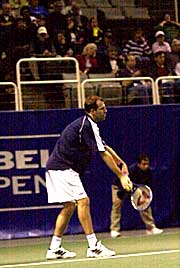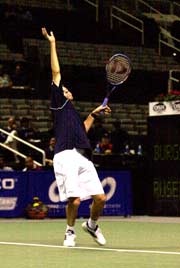<% ns_puts [mkm_getnavbar] %>

The Myth of the Toss
by John Yandell
Still Photos by J Gregory Swendsen
|
"Just throw the ball straight up in front of you and hit it at the top
of
the toss."
This article really should be titled "myths" of the toss, not "the"
myth of the toss, because there are two predominant misunderstandings here
that have damaged players at all levels for years.
The first has to do with toss height - the common belief that
players should hit the ball at the top of the toss.
The second myth has to do with the tossing motion and the placement of the
toss. This is the belief that the toss and the motion of the tossing arm
should be straight up and down in front of the body.
To check if the toss is correct, players are often taught to let the
toss drop, so that it falls to the court in front of the front foot (for a
right-handed player.)
Advanced Tennis (AdvancedTennis.com) high speed video shows that
neither of these two beliefs are accurate. They donít describe what top
players do when they toss. Following these two myths can destroy your
service rhythm and drastically reduce your body leverage, power, and spin.
Myth Versus Reality
When it comes to tossing height, the fact is virtually every
player on tour hits the toss when the ball is on the way down. In most
cases the ball has fallen substantially from the top of the toss, up to
two feet or more at contact.
|
Goran Ivanesivic comes the closest to making contact at the top of the toss, but go to ProStrokes Gallery and see for yourselfóeven his toss has fallen a few inches at the moment of contact.
As for the motion of the tossing arm, no top player uses a straight down and up motion. This is because virtually every good server starts with his shoulders sideways to the net, or turns them sideways at the start of the motion. This means that the tossing arm turns sideways as well.
With the shoulders
sideways, the tossing arm no longer points straight ahead. Instead it
points toward the sideline. The more extreme the shoulder turn, the more
directly the tossing arm points at the sideline.
In the case a player like Pete Sampras, who has the most shoulder turn in
the game, the tossing arm can end at a right angle to the sideline (or
parallel to the baseline) at the time he releases the ball.
For top servers, the tossing arm doesnít move straight up and down, and neither does the flight of the ball during the toss. Rather than moving up and down on a straight line, the path of the ball toss is actually curved like an arc.



Rusedskiís tossing motion. Note how just before the release his tossing arm is angled toward the sideline.
Because the tossing arm is pointing to the side, itís necessary for the
server to toss the ball back towards the contact zone on an arc. For a
right handed player, this arc is from the players right to left.
Since the path of the toss is a curve, not straight up and down, there is
no way for the toss to land in front of the serverís front foot. Instead,
of dropping directly in front of the front foot, the toss would actually
land on the left side of the body.
Sampras Versus Rusedski
Letís examine the toss height, the tossing motion, and the placement of
the toss by comparing two of the top servers in the pro game, Pete Sampras
and Greg Rusedski. They make good examples not only because of their
serving effectiveness, but because of the differences in their technical
styles.
Pete, a righty, has a much higher toss, a much slower rhythm, much more
body coil, and hits with as much topspin on his first serve as any player
in the game.
Rusedski a lefty, with a much lower toss, a very quick delivery, less
knee bend and shoulder turn, and a heavily sliced ball.
The two players probably come close to representing the technical serving extremes in the pro game. But they do share two things when it comes to the toss: both hit the ball well on the way down, and also, while the ball is traveling on an arcing path from the release of the toss back toward the contact zone.
Want to see more high speed video of the serves of top players as well as other strokes? Click here for info on Advanced Tennis high speed digital videos. |
Toss Height
Letís look at the height of the toss first. It has been argued that there are two reasons for hitting the ball at the top of the toss. First, at the top of the toss, the ball is actually stationary for a split second - supposedly, this makes it easier to time. The second argument for hitting the ball at the top is that it forces the player to speed up the motion and therefore increases racquet head speed.
|
Neither of these reasons makes sense. The supposed timing advantage of
hitting the ball when it is still at the top of the toss is negligible at
best. When the ball drops two feet or so before contact, itís velocity is
minimal, 15 mph or less depending on the height of the drop. This is far
less than the speed of a groundstroke hit by an intermediate player (about
40mph). So if you have the ability to rally at even moderate speeds,
hitting a ball dropping at the much slower speed of your toss isnít
going to be a problem.
Second, regarding the alleged gain in racquet head speed from the lower
toss, our studies have shown players with the most racquet head speed,
such as Pete, often have the highest tosses.
A side by side comparison with Rusedski, who has a much lower toss and a
much quicker overall motion, demonstrated the time from racquet drop to
contact was indistinguishable between the two players. If Rusedskiís
quicker motion is giving him more racquet head speed, this gain is easily
matched by the deeper knee bend and greater body turn used by Sampras.
But all these issues are actually secondary to a far more important issue
involving tossing height, one that is not addressed by the low toss
advocates. This is serving rhythm. Rhythm is critical to effective
serving.
Almost all top players need more time to execute their motions than a
super low toss affords. This is the real reason for hitting the ball on
the way down. The height of the toss determines the interval of the
motion. Without enough time, there is no way to develop a relaxed,
comfortable rhythm. To get the time they need, top players
toss the ball substantially above their contact points.
If top pros need the extra time they gain with a high toss, how much more so the average player? This is particularly true when players try to use their legs and increased body rotation for more power and spin. It requires more time to develop more body coil. To get this time, you need a higher toss.
|
Because there is no oncoming ball (with a corresponding oncoming
velocity and oncoming force), the service motion in general is much more
relaxed than are groundstrokes or volleys, both of which involve
collisions with speeding balls.
Itís almost impossible to do all this with an ultra low toss. Thatís why
the few players that have perfected the low toss deliveryóIvanisievic or
Kevin Curren or the legendary Roscoe Tanner--had minimal bio-mechanical
motions relying on the arm swing. Who knows, maybe thatís also one reason
Goran has a rotator cuff that is now 80% torn.
It also worth noting that these are probably the only 3 top players over
the past 30 years who used this motion! Virtually every other top player
on both the menís and womenís side has had a high toss, with the ball
dropping at contact.
I find it amazing that so many coaches,
television commentators, and teachers still seem to believe the best
place to hit the ball is at the top of the toss (Usually they donít even
serve that way themselves!).
Try it yourself. Hit practice serves and gradually lower your toss.
Youíll find there is a point at which you start to tense up and muscle the
racquet in the rush to get to the contact point. For most people, this
tension occurs at a toss height that is still far above the contact point.
That is why trying to lower the toss in the hope of developing more
racquet
head speed is so counterproductive.
Even if you do have a naturally quick rhythm and a minimal biomechanical
motion like Rusedski, the chances are overwhelming youíll still
need to hit the ball on the way down to develop a smooth motion that
doesnít feel rushed and muscled.
Page 2 |
Last Updated 4/1/02. To contact us, please email to: webmaster@tennisone.com
TennisONE is a registered trademark of TennisONE and SportsWeb ONE; Copyright 1995. All rights reserved.




